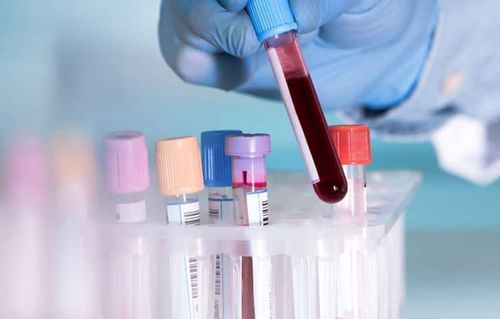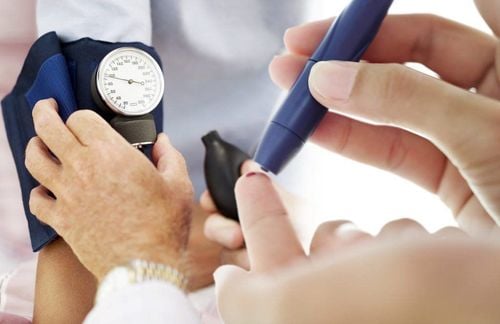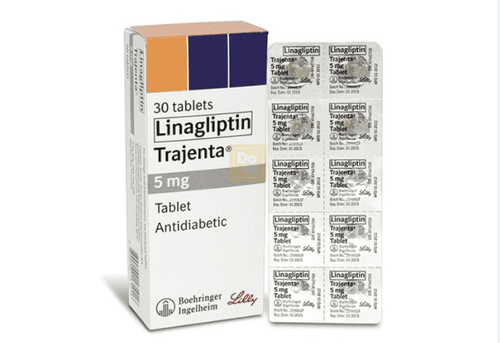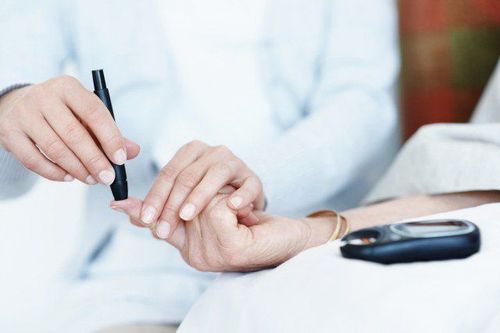This is an automatically translated article.
The article is professionally consulted by Professional Advisor, Associate Professor, Dr. Hoang Dang Mich and Master, Doctor Do Xuan Chien - Department of Medical Examination and Internal Medicine - Vinmec Ha Long International General Hospital.The goal of diabetes treatment is to keep the patient's blood sugar levels stable to prevent unwanted diabetes complications. HbA1c is one of the important indicators to help doctors assess the level of blood sugar stability, however, many diabetics still do not understand the importance of this gold index in blood sugar control.
1. What is HbA1c?
Hemoglobin (Hb) is one of the components that help make up red blood cells, which is responsible for transporting oxygen in the blood. Normally, there is always a binding between blood sugar and hemoglobin of red blood cells.HbA1c is predominant in adults and represents the binding status of sugars on erythrocyte Hb. HbA1c formation occurs as late as 0.05% of the day, and persists for 120 days of erythrocyte life, changing as early as 4 weeks.
2. Overview of HbA1c . Testing

2.1. What is the HbA1c test? The HbA1c (or A1c, glycohemoglobin) test is a blood test used to check the amount of sugar (glucose) attached to hemoglobin in red blood cells.
When hemoglobin and glucose combine, a layer of sugar will form around the hemoglobin. As blood sugar increases, this coating gets thicker and the HbA1c test measures its thickness.
Patients with diabetes or other diseases that increase blood sugar often have more sugar attached to hemoglobin than normal.
2.2. What the HbA1c Test Means The HbA1c test will show a patient's average blood sugar level over the last 2-3 months. This is considered the best test to monitor and control blood sugar levels, helping treating doctors diagnose diabetes or pre-diabetes.
Most doctors think that the HbA1c is the best parameter to see how well a diabetic is controlling his or her condition, indicating whether the diabetes treatment plan needs to be adjusted or not. are not.
In addition, the HbA1c test can also help doctors predict and detect complications from diabetes early, such as kidney failure, eye disease, or numbness in the legs.
HbA1c is elevated in the following cases: Increased blood glucose levels. Newly diagnosed diabetic patient, poorly controlled patient. Chronic renal failure . Anemia. Iron deficiency. Alcoholism. Lead and opium poisoning. HbA1c decreased in the following cases: Chronic blood loss. The life span of red blood cells is shortened: hemolytic anemia, erythrocytosis, sickle cell disease, thalassemia. After blood transfusion. After splenectomy. After taking large doses of vitamin C or E. Pregnancy. 2.3. Normal values of HbA1c At normal levels, HbA1c makes up 4-6% of total hemoglobin.
When the HbA1c index increases above normal 1%, corresponding to an increase in blood sugar value of 30mg/dl or 1.7 Mmol/L.
When HbA1c increases > 10% indicates that your blood sugar has been poorly controlled recently.
A HbA1c < 6.5% indicates good control of your blood sugar, which helps slow and prevent the development of eye, kidney and nerve complications caused by diabetes.
2.4. When should the HbA1c test be performed? Depending on the type of diabetes a patient has, will determine how well the diabetes is controlled, and on the recommendations of the doctor, this test can be done 2–4 times per year. When first diagnosed with diabetes, if your doctor finds that your blood sugar is not well controlled, he or she may order more frequent testing.
For diagnostic and screening purposes, the HbA1c test may be done during routine physical visits or when you are suspected of having diabetes because of signs or symptoms of elevated blood glucose levels (hyperglycemia) such as:
Thirst. Urinating a lot. Fatigue, weakness. Blurred eyes. Long-healing infection. 2.5. How to monitor HbA1c? All patients with type 1 and type 2 diabetes should have an HbA1c test at least twice a year. If blood glucose levels are not stable, test more often (every 3 months).
Blood glucose levels are best controlled when HbA1c is < 6.5% and ideal blood sugar is back to normal. In some cases, a fasting blood sugar level of 150mg% can be tolerated, avoiding low blood sugar <60mg% or hypoglycemia. However, when necessary, you should consult your doctor.
To keep blood glucose levels stable in the long term requires you to strictly adhere to your daily diet, exercise regimen, and medication regimen and self-monitor your blood sugar at home. Controlling stable blood glucose levels continuously 24 hours a day is the key to lowering HbA1c to the target index.

3. HbA1c . test procedure
The test takes about 1 hour, usually in the morning. Before the procedure, the patient does not need to prepare in advance, does not need to fast. The medical staff will perform the test in the following steps:
Step 1: Wrap an elastic band (a tourniquet) around your arm to block the flow of blood.
Step 2: Clean the skin with alcohol.
Step 3: Insert the needle into the vein to draw blood.
Step 4: Remove the tourniquet from the arm when enough health has been collected.
Step 5: Place a gauze or cotton pad over the blood collection site after the needle is removed.
Step 6: Apply pressure to the blood collection site and then apply a bandage. Place the blood sample in the storage tube for testing. Results will be calculated as a percentage of hemoglobin in the blood.
4. Notes on HbA1c . testing
The HbA1c test will not reflect a temporary increase or decrease in blood sugar due to diet or medication and the test will not reflect the ability to control sugar within the previous 3-4 weeks.
If a person has a variant of hemoglobin, such as sickle cell hemoglobin (hemoglobin S), that person will have a reduced amount of normal hemoglobin. This could lead to erroneous HbA1c test results in diagnosing and/or monitoring this person's diabetes, depending on the method used.
If a person has hemolytic anemia, or has heavy bleeding, the HbA1c test result may be lower than its true value. If a person is iron-deficient, the HbA1c level may be higher than its true value.
If a person has had a recent blood transfusion, this test may not be accurate and may not reflect glucose control for 2–3 months.
Before performing this test, you should be aware of the warnings and precautions. If you have any questions, consult your doctor for more information and specific instructions.
Please dial HOTLINE for more information or register for an appointment HERE. Download MyVinmec app to make appointments faster and to manage your bookings easily.













